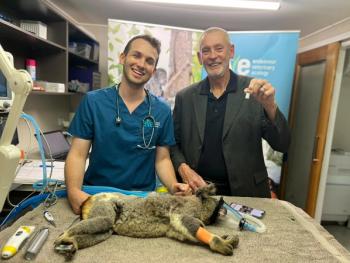
Retrospective study: FIP remains most common feline spinal cord disease
Cats with FIP show multifocal or localized neurologic signs, and they are often younger than 2 years of age.
Feline patients are rapidly becoming a major portion of the small animal clinician's case load. In neurology, the most common etiologies for particular spinal cord lesions do not mirror canine cases. In the past, authors have discussed the various causes of feline spinal cord disease in detail, but without an indication of the respective prevalence of these disease entities (Fenner, W.R. in the second edition of The Cat, Diseases and Clinical Management, Churchill Livingstone, New York, 1994, pgs.1507-68, editor Robert Sherding). Now the clinician has a current reference to suggest the likelihood of a particular disease state when faced with a feline with a neuroanatomic localization of spinal cord disease. A recent retrospective study including 205 cats, published by Marioni-Henry et al, divides the feline spinal cord diseases into seven categories (Table 1, p. 16S). Their order of decreasing prevalence was: inflammatory/infectious (32 percent), neoplastic (27 percent), traumatic (14 percent), congenital/inherited (11 percent), vascular (9 percent), degenerative (6 percent) and metabolic (1 percent) [Prevalence of Diseases of the Spinal Cord of Cats, Marioni-Henry at al, J Vet Intern Med 2004; 18:851-858].
Table 1: Disease categories in order of decreasing prevalence (Marioni-Henry, et al)
The most common spinal cord disorder was feline infectious peritonitis (FIP). FIP induces severe pyogranulomatous meningomyelitis primarily affecting the cervical spinal cord segments. FIP is a surface-related disease, with prevalence in the inner and the outer surfaces of the spinal cord with secondary involvement of the neuroparenchyma. Syringohydromyela is a possible sequellae at any level of the spinal cord. Cats with FIP show multifocal or localized neurologic signs (ataxia, paresis, caudal fossa signs) and they are often younger than 2 years of age.
The second most common spinal cord disorder and the most common spinal cord neoplasia was the lymphosarcoma (LSA). LSA is usually found in the epidural space with rare invasion of the vertebrae, and it is rarely intradural in nature. In the study, 40 percent of LSA effected cats had multifocal cord involvement, 50 percent had brain involvement, and more than 80 percent had LSA in other organ systems concurrently with the spinal cord lesion. LSA is common in all ages and often presents with acute onset and rapid progression of the clinical signs. This may be explained by a relatively slowly-growing compressive extramedullary mass with initial adaptation to the slow compressive forces. However, if the mass occludes a significant blood vessel, it interferes with the spinal cord circulation and thus produces ischemic myelopathy. At this point the clinical signs will become obvious. More than half of the cats with LSA had lesions localized to the lumbosacral segments with or without other segments being affected. LSA causes asymmetric or symmetrical clinical signs such as mono, hemi, para or tetraparaparesis, respectively. In the study, pain was noted in about one third of the LSA patients.
Vertebral column neoplasia was the third common spinal cord disorder in cats. The most common vertebral column neoplasia was osteosarcoma, followed by fibrosarcoma.
Spinal cord disease secondary to trauma had the same prevalence as ischemia or infarct. Injury to the spinal cord can be sustained from extrinsic or intrinsic causes. Extrinsic injury includes vertebral fractures/luxations, subdural hematomas and cellulitis/granulation tissue formation. Examples of intrinsic injuries are intervertebral disc injury or vertebral malformation. Regardless of the etiology, spinal cord injuries result in spinal cord concussion, contusion or laceration. In the case of concussion, the damage may be only temporary. Contusion may cause loss of vascular integrity, hemorrhage and diffuse axonal injury. Laceration is the most severe lesion, when the spinal cord is physically disrupted. Cats that had focal malacia of the spinal cord due to unknown origin were categorized as the ischemic or infarct group. The clinical signs were frequently asymmetric in the study. Fibrocartilaginous embolic myelopathy was not found in this histopathologic study, however sporadic cases are reported in the literature in cats. Acute or peracute onset of the clinical signs were common in both of these groups.
Storage diseases and presumed bacterial infections were less prevalent. Cats in these groups were also commonly younger than 2 years of age.
Intervertebral disc disease (IVDD) was the next most prevalent disorder, often with lumbar localization. The pathophysiology of the IVDD is complex and includes internal traumatic, vascular and degenerative mechanisms. Less than the half of the cats showed pain as part of the clinical presentation.
Neuroaxonal dystrophy and meningeal neoplasia were occasionally found. Meningiomas are the most common primary brain tumors and the most common meningeal spinal cord tumors in cats. These usually occur in middle age and cause extramedullary compression of the spinal cord.
Degenerative diseases, cryptococcosis, intramedullary and extradural neoplasias were the next most prevalent abnormalities effecting the spinal cord. Cryptococcosis produces severe diffuse encephalomyelitis with meningeal predilection.
In contrast to dogs, this organism causes a lesser inflammatory response with minimal granulomatous appearance in cats. In the study, all the cats effected with Cryptococcus presented with caudal fossa signs, and their brains were affected as well.
Finally, occasional cats presented with less common spinal cord diseases including mucopolysaccharidosis VI, trauma from penetrating injury, toxoplasmosis, focal malacia, inflammatory/infectious of unknown origin, eosinophylic meningomyelitis, idiopathic poliomyelitis, syringo-hydromyela and metabolic spinal cord disturbance.
This article allows the practitioner encountering a cat with a spinal cord lesion to understand the relative percentages of probable causes, and develop a diagnostic plan based on this information.
Dr. Nanai is a resident of the European College of Veterinary Neurology/Neurosurgery at the Animal Emergency andReferral Center in Fort Pierce, Fla.
Dr. Lyman is a graduate of The Ohio State University College of Veterinary Medicine. He completed a formal internship at the Animal Medical Center in New York City. Lyman is a co-author of chapters in the 2000 editions of Kirkâs Current Veterinary Therapy XIII and Quick Reference to Veterinary Medicine.
Newsletter
From exam room tips to practice management insights, get trusted veterinary news delivered straight to your inbox—subscribe to dvm360.






